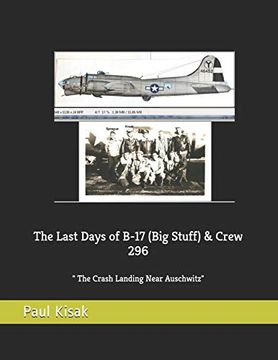The Last Days of B-17 (Big Stuff) & Crew 296: The Crash Landing Near Auschwitz (in English)
Synopsis "The Last Days of B-17 (Big Stuff) & Crew 296: The Crash Landing Near Auschwitz (in English)"
The B-17 "Big Stuff" was in the first formation of B-17's chosen to try daylight bombing. At an altitude off 7000 meters the Flying Fortresses dropped their 16.5 tons of bomb loads. The accuracy of the bomb drop was relatively well, approx. 50% of the bombs hit the target area. All B-17's returned from this deployment, and two escort fighters were lost, while two German hunters were shot. The principal purpose of this first deployment was the acclimatizing of the crews to daylight bombing. The operation confirmed the conception of the American daylight attacks. The other B-17E s which flew on the first mission were: Peggy D, Baby Doll, Berlin Sleeper, Johnny Reb, Birmingham Blitzkrieg along with Big Stuff. A little known factoid is that the safest place in a B-17 was in the ball turret. The most dangerous was in the waist. Daylight bombing in the B-17 was relatively safe all the time they flew in at 7000 Meters (21,000 feet). Unfortunately even the acclaimed Norden Sight was so innacurate at this altitude they had to come down to 15,000-18,000 feet and that is when the casualties started rising.The Norden Bomb sight was mostly inaccurate before Gen LeMay had the bomber formations fly straight and level from the IP to the target. LeMay changed it to where the Lead planes bombadier would aim and all planes would drop on the leads mark. Before the planes would jag to avoid the flak and each plane's bombadier would aim for the target and bomb seperately. A lot of B-17's were lost but they began hitting the target flying straight and level. On 23 March 1945, B-17 #452, "Big Stuff," a/c 44-6452 on Mission #4, bombed a benzene, oil refinery base in Rhuland, Germany at 12:20 pm and an altitude of, 28,000 feet. The crew was assigned to The 20th Bomb Squadron of the 2nd Bomb Group 15th USAAF. At approximately 12:40 in the afternoon B-17 "Big Stuff" was struck by a considerable amount of flak and fire from ME-262's. "Two engines were knocked out immediately" and their B-17 "Big Stuff," headed for a crash landing near Russian lines at co-ordinates 50 deg. 15 min North 14 deg. 15 min east over Lovosice, Germany. The last contact or conversation was with left-waist gunner Russell H. Johnson and he stated "Here we go again." No chutes were seen. Mr. Kisak had been hit with shrapnel in his leg and back (which remained in him and caused him pain the rest of his life) and located himself in the radio room and had the crew brace themselves against him to buffer the impact of the crash. The Flying Fortress crash landed 'wheels-up' 3-5 miles away from Kety Poland. The crew was detained, tortured and interrogated for about 60 days by the Russians who were supposedly our allies. The crew was listed as Missing-In-Action (MIA) and were treated as prisoners-of-war (POW's) by the Russians. The crew was imprisoned about 60 days being moved from Krakow to Livow, to Kiev and finally to Odessa. The personal effects of Mr. Kisak show that he attempted escape in Kiev and was brutally treated and wounded by the Russians that captured him. He had said that a Russian "stabbed me in the stomach when I tried to grab a potato from the hole they kept us in."The crew was under Russian guard for about two months. Then all ten of the crew were sent back to Italy. The crew all boarded a British boat and returned to Italy and arrived at Naples - 7th May 1945. Much appreciation for the contributions of Janusz Wrobel; my friend and expert in bombing and reconnaissance missions conducted over Auschwitz, Poland in 1944,

